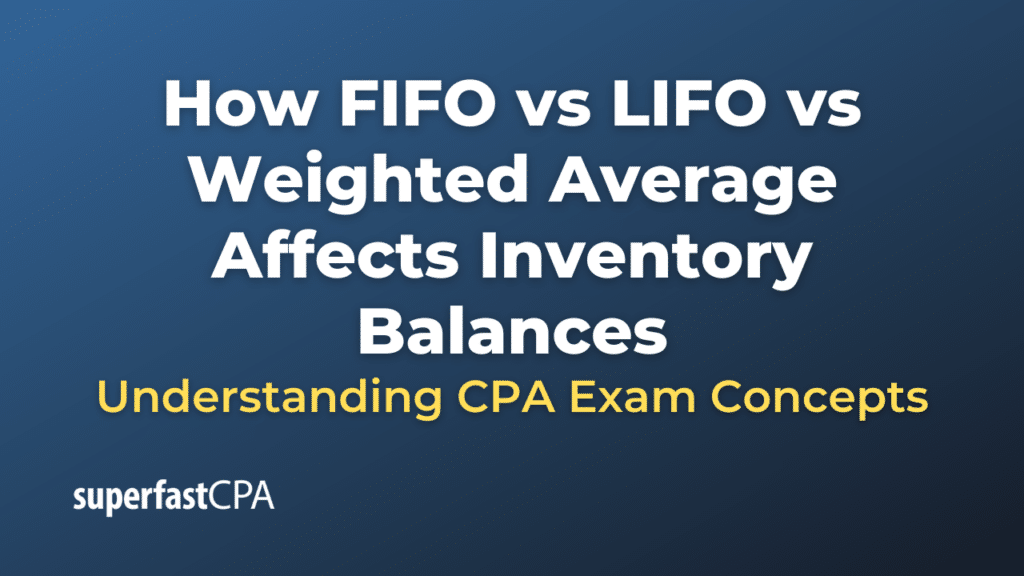Introduction
Brief Introduction to Inventory Management
In this article, we’ll cover how LIFO vs LIFO vs weighted average affects inventory balances. Inventory management is a crucial aspect of running a successful business. It involves overseeing and controlling the ordering, storage, and use of components that a company uses in the production of the items it sells, as well as managing the quantities of finished products available for sale. Effective inventory management ensures that a business maintains the right balance of stock to meet customer demand without incurring excessive holding costs or facing stockouts.
Importance of Inventory Valuation Methods
Inventory valuation methods are essential in determining the cost of goods sold (COGS) and the value of ending inventory. These methods impact a company’s financial statements, affecting profitability, tax liability, and financial health. Accurate inventory valuation is vital for making informed business decisions, securing financing, and maintaining compliance with accounting standards. The choice of inventory valuation method can significantly influence a company’s financial outcomes, especially in periods of fluctuating prices.
Overview of the Three Main Methods: FIFO, LIFO, and Weighted Average
The three primary inventory valuation methods are First-In, First-Out (FIFO), Last-In, First-Out (LIFO), and Weighted Average Cost. Each method has its unique approach to handling inventory costs and can produce different financial results.
- First-In, First-Out (FIFO): This method assumes that the oldest inventory items are sold first. In times of rising prices, FIFO typically results in lower COGS and higher ending inventory values, leading to higher reported profits.
- Last-In, First-Out (LIFO): Contrary to FIFO, LIFO assumes that the most recently acquired items are sold first. During inflationary periods, LIFO can lead to higher COGS and lower ending inventory values, which reduces taxable income but also results in lower reported profits.
- Weighted Average Cost: This method calculates the cost of ending inventory and COGS based on the average cost of all units available for sale during the period. The weighted average cost smooths out price fluctuations and provides a middle ground between FIFO and LIFO in terms of financial impact.
Understanding these methods and their effects on inventory balances is essential for business owners, accountants, and financial analysts to make informed decisions and accurately represent a company’s financial position.
Understanding Inventory Valuation Methods
Explanation of Inventory Valuation
Inventory valuation is the accounting process of assigning a monetary value to a company’s inventory, which includes raw materials, work-in-progress, and finished goods. This valuation determines the cost of goods sold (COGS) and the value of the ending inventory, both of which are crucial for preparing accurate financial statements. The methods used for inventory valuation affect how these costs are calculated and reported.
The primary goal of inventory valuation is to reflect the true cost of inventory on hand at the end of a reporting period and to match the cost of goods sold with the revenue generated from those goods. This process involves selecting an appropriate inventory valuation method, such as FIFO, LIFO, or Weighted Average, each of which applies different assumptions about the flow of inventory costs.
Importance in Financial Reporting and Decision-Making
Inventory valuation plays a pivotal role in financial reporting and decision-making for several reasons:
- Accurate Financial Statements: Inventory valuation impacts the balance sheet and income statement. The ending inventory value appears as a current asset on the balance sheet, while the COGS is deducted from revenue to calculate gross profit on the income statement. Accurate valuation ensures that these financial statements present a true and fair view of the company’s financial position and performance.
- Tax Implications: Different inventory valuation methods can lead to different taxable incomes. For instance, during periods of rising prices, using LIFO can result in higher COGS and lower taxable income compared to FIFO. Companies must carefully consider the tax implications of their chosen inventory valuation method.
- Profitability Analysis: Inventory valuation affects gross profit and net income, which are critical metrics for assessing a company’s profitability. Businesses rely on these metrics to make strategic decisions, such as pricing, budgeting, and forecasting.
- Inventory Management: Understanding the value of inventory helps businesses manage their stock levels more effectively. It enables them to optimize inventory turnover, reduce holding costs, and avoid stockouts or overstock situations.
- Investor Confidence: Investors and stakeholders use financial statements to evaluate a company’s performance and make investment decisions. Consistent and accurate inventory valuation enhances the credibility of financial reports and builds investor confidence.
- Compliance with Accounting Standards: Adhering to Generally Accepted Accounting Principles (GAAP) or International Financial Reporting Standards (IFRS) requires accurate inventory valuation. Compliance ensures that financial statements are comparable, transparent, and reliable, facilitating better decision-making for internal and external stakeholders.
Inventory valuation is a critical aspect of financial reporting and decision-making. It affects a company’s profitability, tax liability, and overall financial health, making it essential for businesses to choose the appropriate valuation method and apply it consistently.
First-In, First-Out (FIFO)
Definition and Basic Concept
First-In, First-Out (FIFO) is an inventory valuation method that assumes the oldest inventory items are sold first. Under FIFO, the cost of goods sold (COGS) is based on the cost of the earliest purchased items, while the remaining inventory is valued at the cost of the most recent purchases. This method aligns closely with the actual physical flow of inventory for many businesses, particularly those dealing with perishable goods.
How FIFO Works in Practice
In practice, FIFO involves keeping track of inventory purchases and sales to ensure that the costs are assigned appropriately. When a sale occurs, the cost of the oldest inventory items is used to calculate COGS. The remaining inventory is then composed of the more recently acquired items.
Example Calculations
Consider a company that sells widgets and has the following inventory transactions:
- January 1: Purchase 100 widgets at $10 each
- February 1: Purchase 100 widgets at $12 each
- March 1: Purchase 100 widgets at $14 each
If the company sells 150 widgets on March 10, the COGS would be calculated as follows:
- 100 widgets from January 1 purchase at $10 each = $1,000
- 50 widgets from February 1 purchase at $12 each = $600
Total COGS = $1,600
The ending inventory would consist of:
- 50 widgets from February 1 purchase at $12 each = $600
- 100 widgets from March 1 purchase at $14 each = $1,400
Total ending inventory = $2,000
Advantages and Disadvantages
Impact on Inventory Balances During Inflation and Deflation
- Inflation: During periods of rising prices, FIFO results in lower COGS because the older, cheaper inventory is used first. This leads to higher ending inventory values, as the more recent, higher-cost inventory remains on hand.
- Deflation: Conversely, during periods of falling prices, FIFO results in higher COGS and lower ending inventory values, as the older, more expensive inventory is used first.
Effects on Financial Statements
- Balance Sheet: FIFO typically results in higher inventory values on the balance sheet during inflationary periods. This can improve a company’s current ratio and perceived financial health.
- Income Statement: With lower COGS during inflation, FIFO can lead to higher gross profit and net income. However, this also means higher tax liabilities due to increased taxable income.
Tax Implications
Under FIFO, companies may face higher tax liabilities during periods of rising prices because of the higher net income reported. This is a critical consideration for businesses when choosing an inventory valuation method, as it directly affects cash flow and financial planning.
FIFO is a straightforward and logical method that often mirrors the physical flow of goods. It provides several benefits, particularly in presenting higher profitability during inflationary times, but also comes with the drawback of potentially higher tax liabilities. Businesses must weigh these factors when deciding if FIFO is the most suitable method for their inventory valuation needs.
Last-In, First-Out (LIFO)
Definition and Basic Concept
Last-In, First-Out (LIFO) is an inventory valuation method that assumes the most recently acquired inventory items are sold first. Under LIFO, the cost of goods sold (COGS) is based on the cost of the latest purchases, while the remaining inventory is valued at the cost of the earlier purchases. This method is often used by companies looking to reduce their tax liabilities during periods of rising prices, as it typically results in higher COGS and lower taxable income.
How LIFO Works in Practice
In practice, LIFO involves tracking inventory purchases and sales to ensure that the most recent costs are assigned to COGS. When a sale occurs, the cost of the newest inventory items is used to calculate COGS. The remaining inventory is then composed of the older, lower-cost items.
Example Calculations
Consider a company that sells gadgets and has the following inventory transactions:
- January 1: Purchase 100 gadgets at $10 each
- February 1: Purchase 100 gadgets at $12 each
- March 1: Purchase 100 gadgets at $14 each
If the company sells 150 gadgets on March 10, the COGS would be calculated as follows:
- 100 gadgets from March 1 purchase at $14 each = $1,400
- 50 gadgets from February 1 purchase at $12 each = $600
Total COGS = $2,000
The ending inventory would consist of:
- 50 gadgets from February 1 purchase at $12 each = $600
- 100 gadgets from January 1 purchase at $10 each = $1,000
Total ending inventory = $1,600
Advantages and Disadvantages
Impact on Inventory Balances During Inflation and Deflation
- Inflation: During periods of rising prices, LIFO results in higher COGS because the most recent, higher-cost inventory is used first. This leads to lower ending inventory values, as the older, lower-cost inventory remains on hand.
- Deflation: Conversely, during periods of falling prices, LIFO results in lower COGS and higher ending inventory values, as the more recent, lower-cost inventory is used first.
Effects on Financial Statements
- Balance Sheet: LIFO typically results in lower inventory values on the balance sheet during inflationary periods. This can reduce a company’s current ratio and perceived financial health.
- Income Statement: With higher COGS during inflation, LIFO can lead to lower gross profit and net income. However, this also means lower tax liabilities due to decreased taxable income.
Tax Implications
Under LIFO, companies may face lower tax liabilities during periods of rising prices because of the higher COGS and lower net income reported. This can improve cash flow and provide a financial advantage in times of inflation. However, it is important to note that LIFO is not permitted under International Financial Reporting Standards (IFRS), and its use is restricted to certain jurisdictions, such as the United States, under Generally Accepted Accounting Principles (GAAP).
LIFO is a method that can provide tax advantages during inflationary periods by reducing taxable income. It also has the potential to decrease a company’s reported profitability and perceived financial health due to lower inventory values on the balance sheet. Businesses must carefully consider these factors, along with regulatory compliance, when deciding if LIFO is the most suitable method for their inventory valuation needs.
Weighted Average Cost
Definition and Basic Concept
The Weighted Average Cost (WAC) method, also known as the Average Cost Method, is an inventory valuation method that calculates the cost of ending inventory and the cost of goods sold (COGS) based on the average cost of all units available for sale during the period. This method smooths out price fluctuations and provides a balanced approach to inventory valuation, neither favoring the oldest nor the newest inventory.
How Weighted Average Works in Practice
In practice, the Weighted Average Cost method involves calculating the average cost per unit of inventory at each point in time when inventory is purchased. This average cost is then used to determine both the cost of ending inventory and COGS. The formula for calculating the weighted average cost per unit is:
\(\text{Weighted Average Cost per Unit} = \frac{\text{Total Cost of Inventory}}{\text{Total Units Available for Sale}} \)
Example Calculations
Consider a company that sells tools and has the following inventory transactions:
- January 1: Purchase 100 tools at $10 each
- February 1: Purchase 100 tools at $12 each
- March 1: Purchase 100 tools at $14 each
The total cost and total units available for sale by March 1 would be:
- Total cost of inventory: (100 * $10) + (100 * $12) + (100 * $14) = $1,000 + $1,200 + $1,400 = $3,600
- Total units available for sale: 100 + 100 + 100 = 300
The weighted average cost per unit would be:
\(\text{Weighted Average Cost per Unit} = \frac{\$3,600}{300} = \$12 \)
If the company sells 150 tools on March 10, the COGS would be calculated as:
COGS = 150 × $12 = $1,800
The ending inventory would be calculated as:
Ending Inventory = (300 − 150) × $12 = 150 × $12 = $1,800
Advantages and Disadvantages
Impact on Inventory Balances
The Weighted Average Cost method results in inventory balances that reflect an average cost, which tends to smooth out the effects of price volatility. This method provides a balanced view of inventory value, avoiding the extremes of FIFO (high ending inventory value during inflation) and LIFO (low ending inventory value during inflation).
Effects on Financial Statements
- Balance Sheet: The ending inventory value reported on the balance sheet is an average cost, which can provide a stable and consistent valuation over time. This stability can make financial statements easier to compare across periods.
- Income Statement: The COGS reported on the income statement is also based on an average cost, which can lead to more stable gross profit margins. This consistency can simplify financial analysis and forecasting.
Tax Implications
The Weighted Average Cost method can have varying tax implications depending on the price trends of inventory. During periods of price stability, the tax impact is neutral. However, in times of significant price fluctuations, the tax implications will be moderate compared to FIFO and LIFO. This method does not provide the tax deferral benefits of LIFO during inflationary periods but also does not result in higher taxable income as significantly as FIFO might.
The Weighted Average Cost method offers a balanced approach to inventory valuation, providing stability in financial reporting and minimizing the impact of price fluctuations. It is a practical choice for businesses seeking consistent and straightforward inventory accounting.
Comparative Analysis
Detailed Comparison of FIFO, LIFO, and Weighted Average
The FIFO, LIFO, and Weighted Average inventory valuation methods each have distinct characteristics that impact how inventory is valued and reported. Here’s a detailed comparison:
- FIFO (First-In, First-Out): Assumes the oldest inventory is sold first. Commonly used when the physical flow of goods matches this assumption, such as with perishable goods.
- LIFO (Last-In, First-Out): Assumes the most recently acquired inventory is sold first. Often used in industries where inventory costs are rising, as it can reduce taxable income.
- Weighted Average Cost: Calculates an average cost for all inventory items. Useful in industries with fluctuating prices, as it smooths out cost variations.
How Each Method Affects Inventory Balances Differently
- FIFO: Results in higher ending inventory values during periods of rising prices, as the newer, more expensive inventory remains on hand.
- LIFO: Leads to lower ending inventory values during inflation, as the newer, more expensive inventory is sold first.
- Weighted Average Cost: Produces inventory values that are an average of all costs, providing a middle ground between FIFO and LIFO.
Impact on Cost of Goods Sold (COGS)
- FIFO: Yields lower COGS during inflation since older, cheaper inventory is used first. This increases gross profit.
- LIFO: Results in higher COGS during inflation because newer, more expensive inventory is used first. This decreases gross profit.
- Weighted Average Cost: Generates a COGS that reflects an average cost, leading to more stable and consistent gross profit margins over time.
Effect on Profitability and Taxes
- FIFO: Increases reported profitability during inflationary periods due to lower COGS. However, this also results in higher taxable income and tax liabilities.
- LIFO: Decreases reported profitability during inflationary periods due to higher COGS, which can lower taxable income and reduce tax liabilities.
- Weighted Average Cost: Provides a balanced effect on profitability and taxes, with neither the significant tax benefits of LIFO nor the increased tax liabilities of FIFO.
Situations Where Each Method Is Most Appropriate
- FIFO: Best suited for businesses where inventory must be sold in a specific order, such as perishable goods, and in environments with stable or deflationary price trends.
- LIFO: Ideal for businesses operating in inflationary environments, seeking to minimize tax liabilities, and where inventory does not need to be used or sold in a specific order. Note that LIFO is not permitted under IFRS.
- Weighted Average Cost: Appropriate for businesses with significant price volatility and those seeking consistency in inventory valuation and COGS. This method is straightforward and provides a balanced approach to inventory accounting.
Each inventory valuation method has its unique benefits and drawbacks, impacting inventory balances, COGS, profitability, and tax liabilities differently. The choice of method should align with a company’s specific circumstances, industry practices, and financial goals.
Real-World Applications and Industry Practices
Common Industries Using Each Method
- FIFO (First-In, First-Out): This method is widely used in industries where products have a limited shelf life or need to be used in a specific order. Examples include:
- Food and Beverage: Perishable goods must be sold before they spoil.
- Pharmaceuticals: Medicines and drugs need to be sold before their expiration dates.
- Retail: Fashion and electronics industries often use FIFO to ensure the oldest inventory is sold first.
- LIFO (Last-In, First-Out): This method is more common in industries where inventory costs are rising and companies are looking to minimize tax liabilities. Examples include:
- Oil and Gas: Prices of raw materials like crude oil fluctuate frequently.
- Metals and Mining: Costs of metals and minerals often rise due to demand and supply changes.
- Retail: Some large retailers use LIFO for tax advantages in inflationary periods.
- Weighted Average Cost: This method is used in industries where prices fluctuate frequently and companies seek a balanced approach. Examples include:
- Manufacturing: Companies dealing with raw materials and components that have variable costs.
- Technology: Tech firms that manage large inventories of components with varying prices.
- Consumer Goods: Companies producing fast-moving consumer goods (FMCGs) with diverse product lines.
Case Studies or Examples from Companies
- FIFO Example: A leading global retailer like Walmart uses FIFO for its inventory management. By selling the oldest inventory first, Walmart ensures that its products are fresh, especially in the grocery section. This method helps maintain customer satisfaction and reduces spoilage costs.
- LIFO Example: An oil and gas company like ExxonMobil uses LIFO to manage its inventory costs. During periods of rising oil prices, LIFO allows ExxonMobil to account for the higher costs of recent purchases, reducing taxable income and providing tax benefits.
- Weighted Average Cost Example: A consumer electronics manufacturer like Samsung uses the Weighted Average Cost method. This approach helps Samsung manage the costs of components that fluctuate frequently, providing a consistent and balanced cost structure for its diverse product range.
How Companies Switch Between Methods and the Implications
Switching between inventory valuation methods is a significant decision that can have various implications for a company:
- Regulatory Compliance: Companies must adhere to accounting standards such as GAAP or IFRS when changing inventory valuation methods. A change typically requires justification and consistency in application.
- Financial Statements: Switching methods can impact the financial statements significantly. For instance, moving from LIFO to FIFO during inflationary periods can increase reported income, impacting profitability metrics and potentially leading to higher tax liabilities.
- Tax Implications: Changing methods can affect taxable income. Companies switching from FIFO to LIFO may benefit from reduced tax liabilities during inflation. Conversely, switching from LIFO to FIFO could result in higher taxes.
- Investor Relations: Consistency in financial reporting is crucial for investor confidence. Frequent changes in inventory valuation methods can lead to perceptions of financial manipulation, affecting investor trust.
- Operational Adjustments: Companies may need to adjust their inventory management systems and processes to accommodate the new valuation method. This may involve training staff and updating software systems.
Example of Switching Methods: A company in the retail industry, such as Macy’s, might decide to switch from LIFO to FIFO to better reflect the actual flow of goods and improve financial reporting transparency. This switch would require adjustments in their accounting systems and processes, but it could provide more accurate inventory valuations and enhance investor confidence.
Different industries adopt various inventory valuation methods based on their specific needs and market conditions. Case studies highlight how companies effectively use these methods, and switching between methods requires careful consideration of regulatory, financial, and operational impacts.
Conclusion
Summary of Key Points
In this article, we explored the three primary inventory valuation methods: First-In, First-Out (FIFO), Last-In, First-Out (LIFO), and Weighted Average Cost. Each method has distinct characteristics and impacts on inventory balances, cost of goods sold (COGS), profitability, and tax liabilities.
- FIFO assumes the oldest inventory is sold first, leading to lower COGS and higher ending inventory values during inflation, resulting in higher taxable income.
- LIFO assumes the most recent inventory is sold first, resulting in higher COGS and lower ending inventory values during inflation, which can reduce taxable income.
- Weighted Average Cost calculates an average cost for all inventory items, providing stability and consistency in financial reporting.
Final Thoughts on the Importance of Choosing the Right Inventory Valuation Method
Choosing the right inventory valuation method is crucial for accurate financial reporting and strategic business decisions. The method selected can significantly impact a company’s profitability, tax liabilities, and overall financial health. It is essential to consider the specific needs of the business, the nature of the inventory, and the economic environment when making this decision. Consistent application of the chosen method ensures transparency and reliability in financial statements, which is vital for maintaining investor confidence and compliance with accounting standards.
Recommendations for Businesses
- Evaluate Business Needs: Assess the nature of your inventory and the industry in which you operate. Consider how price fluctuations affect your inventory costs and how each valuation method would impact your financial statements.
- Consult with Financial Experts: Seek advice from accountants and financial advisors to understand the implications of each inventory valuation method on your business’s financial health and tax obligations.
- Consider Regulatory Requirements: Ensure that your chosen inventory valuation method complies with relevant accounting standards (GAAP or IFRS) and regulatory requirements.
- Analyze Financial Impact: Perform scenario analyses to understand how different valuation methods would affect your COGS, profitability, and tax liabilities under various economic conditions.
- Maintain Consistency: Once a method is chosen, apply it consistently across reporting periods to ensure comparability and reliability of financial statements.
- Monitor Economic Conditions: Stay informed about changes in economic conditions and industry practices that may warrant a reevaluation of your inventory valuation method.
In conclusion, the right inventory valuation method can provide significant benefits to a business, including accurate financial reporting, optimized tax planning, and better strategic decision-making. By carefully evaluating and selecting the appropriate method, businesses can enhance their financial performance and maintain a strong, transparent relationship with investors and stakeholders.
Additional Resources
Links to Further Reading
- Understanding Inventory Valuation Methods – Investopedia provides a comprehensive overview of inventory valuation methods and their implications.
- FIFO vs LIFO: What’s the Difference? – AccountingTools offers a detailed comparison between FIFO and LIFO methods.
- Inventory Costing Methods – FreshBooks explains various inventory costing methods and their impact on financial statements.
- How to Choose the Right Inventory Valuation Method – QuickBooks provides guidance on selecting the best inventory valuation method for your business.
Tools and Software for Inventory Management
- QuickBooks Inventory Management: An integrated solution for tracking inventory, managing orders, and generating financial reports.
- NetSuite Inventory Management: A comprehensive cloud-based ERP system that offers advanced inventory management capabilities.
- Zoho Inventory: A robust inventory management software designed for small to medium-sized businesses, offering features like order management, warehouse management, and integrations with e-commerce platforms.
- Fishbowl Inventory: An inventory management solution that integrates with QuickBooks, providing features like order management, manufacturing, and asset tracking.
- SAP Business One: An ERP solution designed for small and medium-sized enterprises, offering advanced inventory and supply chain management capabilities.
Professional Advice and Consulting Services
- PwC Inventory Management Consulting: PwC provides consulting services to help businesses optimize their inventory management processes and improve operational efficiency.
- Deloitte Supply Chain and Inventory Management Services: Deloitte offers comprehensive services to enhance inventory management, reduce costs, and improve supply chain performance.
- KPMG Inventory and Supply Chain Consulting: KPMG provides strategic advice and practical solutions to improve inventory management and supply chain operations.
- Ernst & Young (EY) Supply Chain & Operations Consulting: EY offers services to optimize supply chain and inventory management, helping businesses achieve greater efficiency and cost savings.
- Grant Thornton Inventory Management Services: Grant Thornton provides inventory management consulting to help businesses enhance their inventory practices and achieve operational excellence.
These additional resources, tools, and professional services can provide valuable support for businesses looking to improve their inventory management practices. By leveraging these resources, companies can make informed decisions, optimize their inventory processes, and enhance their overall financial performance.













